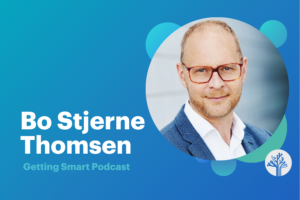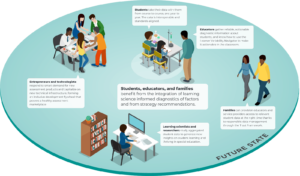Middle Grade Math: Comprehensive and Open

The intermediate grades serve as formative years for conceptual understanding of content as well as an emotional connection to math.
While students learn key concepts that they will carry with them throughout their math careers, they are also developing their love (or hate) of the subject. The stronger the conceptual understanding of key skills and concepts such as fractions, mathematical representations, functions and problem-solving that students build, the more they are set up for success down the line.
Open content is changing the game for educators across grades and subjects, but when it comes to open content in the math classroom, it can frequently be a job in itself for teachers to piece together the resources they need to best support their students.
Open Up Resources is hoping to change that with its mathematics curriculum authored by Illustrative Mathematics.
 Open Up Resources is a national nonprofit that originated as an open education resource (OER) collaborative founded by 13 states, and has assembled a small distributed team of experienced K-12 executives who contract with best-in-class partners for high-quality standards-aligned curriculum.
Open Up Resources is a national nonprofit that originated as an open education resource (OER) collaborative founded by 13 states, and has assembled a small distributed team of experienced K-12 executives who contract with best-in-class partners for high-quality standards-aligned curriculum.
Its 6th – 8th-grade math program is currently in the pilot phase in six districts (from a variety of different regions as well as student populations). The goal is an open yet completely comprehensive math program for all.
As CEO Larry Singer notes, “Students in private prep schools have access to high-quality curriculum. We want school districts to have access to high-quality standards-aligned content.”
After having the chance to review the program, I was most impressed by its focus on these seven areas:
Making Connections. One important element to math education that is frequently overlooked is a student’s ability to make connections: connections between concepts that they are learning about; connections between group discussions and independent practice; and the connection between classroom activities and the real world.
The Open Up Math Resources put an emphasis on concept connections in a unique way that not only support student understanding of content but also help teachers, especially those who may have a limited background in advanced mathematics, see clearly how the “math story” comes together.
Scope & Sequence. The program is clearly designed to support teachers and students in making a clear connection to content and concepts. And for the curriculum team, it is more than just the final “Putting It All Together” unit (this is a unit designed to tie activities and concepts together while also advancing understanding by formalizing connections–each course has one).
It is a scope and sequence designed around creating and utilizing connections to content, and the teacher resources provide a clear overview of content overlap and concept connection. The scope and sequence are clearly articulated and take an untraditional (but conceptually sound) approach to curriculum planning.
Ongoing Support & Resources. In addition to teacher resources, Open Up prepares family resources for each unit that explain key concepts in both English and Spanish and are designed for meaningful at-home conversations
They also have specific supports embedded in the lesson for English Language Learners (ELLs) and students with disabilities that provide additional instructional suggestions for the teacher. The materials include eight mathematical language routines used across lessons and units, specifically designed to meet the needs of ELL students in math.
 Mathematical Practices. Student opportunities to engage in the standards for mathematical practice (MP) are infused throughout the curriculum, with a focus on the MPs that are most appropriate for a particular point in learning.
Mathematical Practices. Student opportunities to engage in the standards for mathematical practice (MP) are infused throughout the curriculum, with a focus on the MPs that are most appropriate for a particular point in learning.
Growth Mindset. Within the lessons, teachers are provided with the most common misconceptions. These serve not only as useful tools for teachers to quickly identify comprehension gaps but can also be given to students to showcase the value of learning from mistakes, as well as help begin a conversation around the content. All lessons contain strategically embedded review aimed at true fluency.
Mathematical Modeling. Preparation for more advanced mathematical modeling starts early, or as the team says, “Getting students to apply mathematics to real-world problems requires deliberate cultivation.”
Throughout their work, students have the chance to practice problems that address three essential dimensions: Collecting and selecting information, choosing a model and processing information/data.
Iterative Approach. At the close of each lesson, the teacher is prompted with a short survey to provide Open Up with meaningful data that helps guide lesson and unit development. Not only does this help the team fine-tune lesson timing and structure, but also gives teachers the opportunity to be a part of program development.
Six pilot districts (with 120+ teachers in 30 middle schools) began using the program this school year and provide regular feedback. The Illustrative Math team is actively reviewing the feedback and incorporating it into the final version of the materials, which will publish as OER for the 2017-2018 school year. If you are interested in learning more, visit openupresources.org or send an email to [email protected].
The commitment to gathering and responding to user feedback indicates that we will also see a dedication to continued innovation and improvement. We look forward to hearing what is next!
For more, see:
- Vancouver Pilots Comprehensive Open Math Curriculum
- Open Up: High-Quality Standards-Aligned Math Curriculum
- Getting Smart Podcast | Cultivating Young Mathematicians
Stay in-the-know with all things EdTech and innovations in learning by signing up to receive the weekly Smart Update. This post includes mentions of a Getting Smart partner. For a full list of partners, affiliate organizations and all other disclosures please see our Partner page.







0 Comments
Leave a Comment
Your email address will not be published. All fields are required.